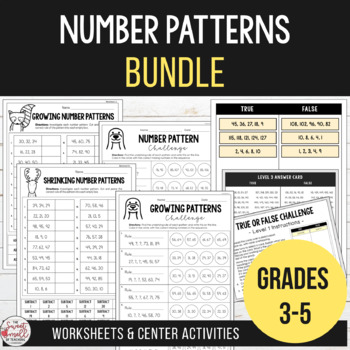Number Patterns Bundle - Investigate Growing & Shrinking Number Patterns
- Zip
What educators are saying
Products in this Bundle (4)
Also included in
- Number Patterns Digital & Print Bundle - Investigate Growing Shrinking PatternsDevelop your students understanding of number patterns with these engaging worksheets and center activities. Students will use their analytical skills to investigate underlying rules in numerical patterns.Resource insPrice $11.44Original Price $14.30Save $2.86
Description
Number Patterns Bundle - Investigate Growing & Shrinking Number Patterns
Develop your students understanding of number patterns with these engaging worksheets and center activities. Students will use their analytical skills to investigate underlying rules in numerical patterns.
Resource instructions and answer keys provided for all worksheets and activities.
This product includes:
• Growing & Shrinking Number Patterns - Christmas Edition
• Growing & Shrinking Number Patterns - Challenge Sheets
• Growing & Shrinking Number Patterns - True or False Challenge Cards
• Identifying Pattern Rules in Growing and Shrinking Number Patterns - Worksheets
★★ Don't forget to follow my store for updates on freebies, sales, and new products!
Follow The Sweet Smell of Teaching on TpT.
If you like this product, you may also be interested in these resources:
Operations & Algebraic Thinking
• Multiplication Games - Memory Cards
• Balance the Equations - True or False Equivalence Challenge Cards
• Balancing Equations - Equivalent Number Sentence Challenge Sheets
• Balance the Equation - Equivalent Number Sentence Jigsaw Activity
Number & Operations in Base Ten
• Rounding Numbers - Task Card Activities
• Addition & Subtraction with Regrouping Activities
• Addition & Subtraction with Regrouping Activities - Back to School Edition
Number & Operations - Fractions
• Comparing Fractions, Decimals & Percents - Comparison Cards & Worksheets
• Fraction and Decimal Games - Memory Cards
Measurement & Data
• Metric Measurement Conversions - True or False Challenge Cards



